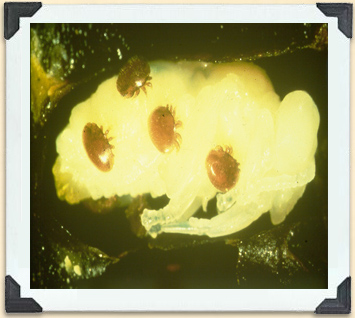The Keeper

Varroa mites on a pupa.
© University of Manitoba
Varroa Mites
Varroa mites are one of the most serious problems that bees face. Beekeepers must be on constant alert for their presence since, despite the fact that they are about the size of a pinhead, they can, over time, destroy an entire colony. These parasitic mites reproduce quickly, attaching themselves to bees and feeding on their hemolymph fluid (the blood of arthropods). They are especially attracted to drone larvae.
Mites have almost entirely eliminated the wild bee population. Beekeepers can reduce the mite population in their colonies by chemical and mechanical controls, such as a screened bottom board that traps the mites. When chemical controls are being used in the hive, the honey supers are removed to avoid chemical residues ending up in the honey.


